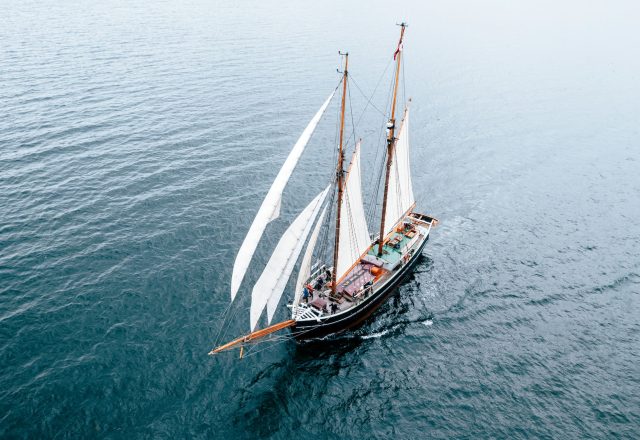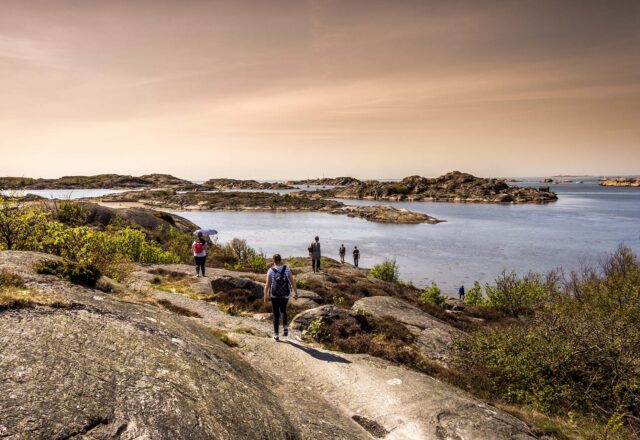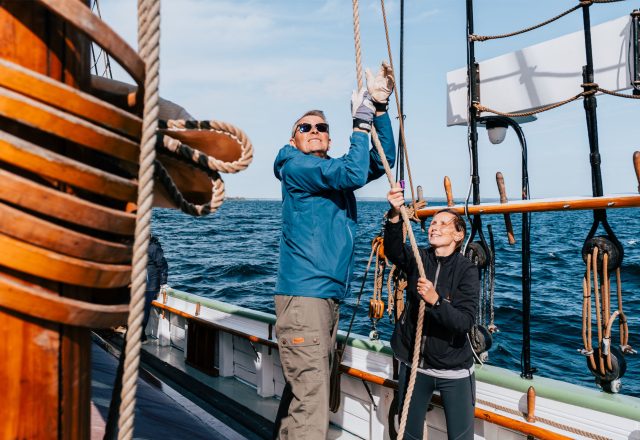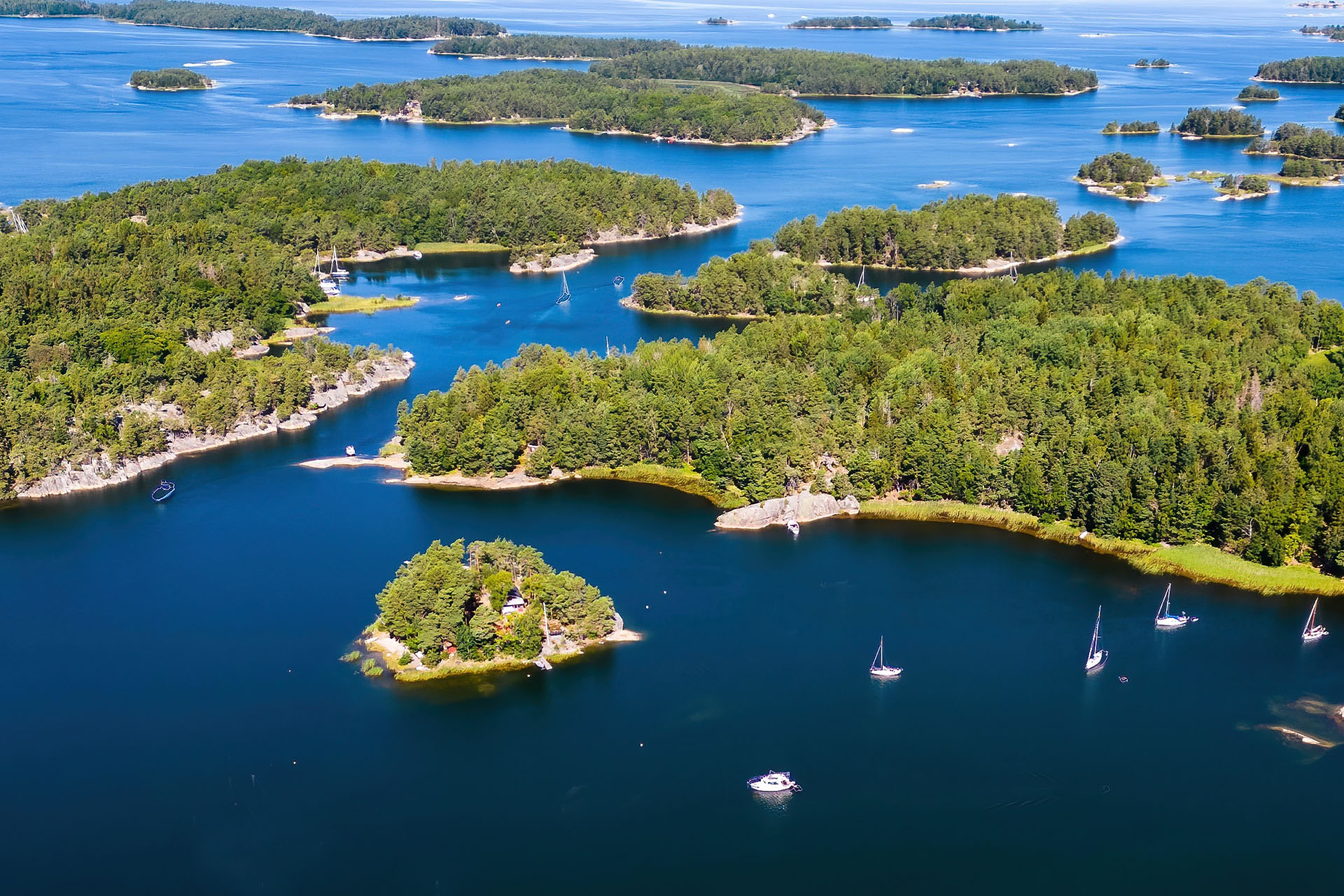
When you’re never more than 32 miles from the coast, Denmark is truly a hidden gem in the sailing world. Tucked into the shelter of the Baltic Sea, with some 444 islands to explore, sailing in Denmark is much more accessible than you might think. A few members of the VentureSail team joined Aron of Svendborg for five days, island hopping the South Funen archipelago. Here, our Operations Manager Naomi shares her ultimate Denmark travel guide.
Denmark Travel Guide: UK to Svendborg
Our Denmark travel guide begins in the UK. With flight times to Denmark sitting at under two hours, we awoke in the UK and fell asleep to the gentle waves of the Baltic Sea! Most major UK airports (Gatwick, Heathrow, Stansted, Bristol, Edinburgh, Newcastle, Manchester, Birmingham) fly to Denmark’s capital Copenhagen. A number of UK airports also fly to Billund, which is another simple route to reach Svendborg. It’s worth checking both locations to see what works for you. We chose to fly in and out of Copenhagen to allow for a short break in the capital!
As we were travelling to meet Aron in Svendborg, on the island of Funen, there were different route options to consider. The most direct route from Copenhagen was a one change train through to Odense and then onto Svendborg. You won’t need to book separate tickets, just pop Copenhagen > Svendborg into the DSB site and it will find the route for you. Odense isn’t a huge station so changing trains is straight-forward and there are plenty of display boards to help find which track you’ll need to be on!
Hailing from Cornwall, our team were a little dubious about public transport being on time to make a connection. However, Denmark runs like clockwork, making the travel to and from the boat surprisingly relaxing and an enjoyable part of the adventure. The train journey is about 2.5 hours so it was time to sit back and enjoy the green countryside landscape roll by. DSB Standard class is similar to the UK’s First Class – another example of the Danes really doing things well!
Denmark Travel Guide: Joining Aron in Svendborg

Svendborg is a bustling harbour town and our first impression was of how clean and well-kept everything is. The marina is a stone’s-throw from the train station, less than 5 minutes down the street and across the road. If you have some time to spare, there are plenty of coffee shops around the station or benches by the marina to watch the comings and goings.
Usually Aron moors on the main marina edge, so you’ll spot her on the stroll down from the train station! Once aboard, we met our fellow guests and had our cabins allocated. After a brief chat over a coffee we made our way on deck for a safety briefing.
The makeup of guests on board varies, on our trip roughly half the guests were British, and half were Danish, which was a nice dynamic. The skipper, crew, and other Danish guests spoke excellent English so communication and instruction on board was predominantly English. The other guests and crew were quick to confer in Danish if they were searching for an English word to share with us!


Skipper Helene used to teach sail training, so armed with her chalk pot, she gathered us all on the fore deck. Here, Helene drew out how the wind direction would affect sail hoisting and who would be standing where, and pulling what ropes. Her instruction was so clear and simple, everyone just seemed to pull together, quite literally at the right time. We had assumed some guests on board were experienced sailors – but it turns out they’d never sailed a traditional ship before. Under Helene’s guidance, everyone was able to quickly learn the ropes and join together in sailing this beautiful ship.
Denmark travel guide: Island Hopping in South Funen
Day 1:
As a general rule, Aron does not anchor in the Danish archipelago of South Funen, instead opting to moor on the islands themselves. This is due to the shallow waters and shifting sand bars found at anchor. We found mooring up on the islands is a far better option, as you explore at your own pace. As we waited for dinner, some walked to the island centre and some stayed on board, chatting or napping. The mornings mirrored this as early risers walked to catch the sunrise. Some of us went for a swim – even in September it was surprisingly warm, and those that preferred were able to have a lie in.



Aron does have a shower onboard but actually, none of us used it. The promise of onshore showers made us a little hesitant with memories of typical British shower blocks. But how wrong we were! To not use the Danish marina facilities would have meant missing out. The facilities were spacious and really clean with full working taps, showers and dryers – not a push button in sight. An abundance of hot water and of course, some were so efficient that we had sensor showers. So in the words of Gorm the skipper “as long as you keep dancing, you can keep the water coming”.


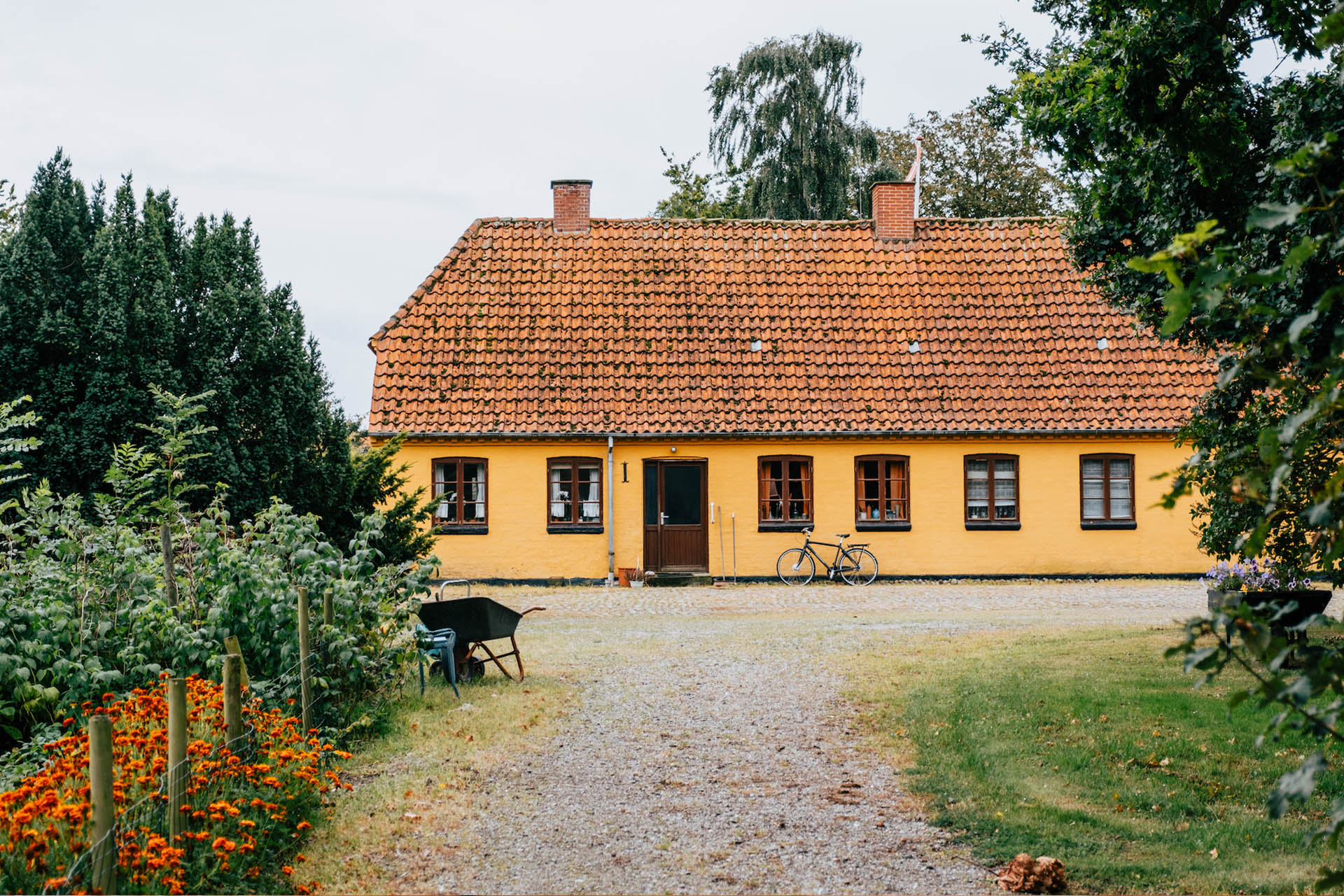
The sleepy island of Lyo was our first stop. The island is home to only about 80 inhabitants and a handful of cars. You can hire a bicycle to explore or just take a walk, it’s relatively flat to navigate. There’s a small local produce shop and artisan cafe in the “village centre” (about a 15 minute walk from the marina) selling the local honey made on the island. Traditional farmhouses nestle between the island’s five ponds, and ducks and chickens roam the tracks. The whitewashed 17th century church sits in the only circular graveyard in the whole of Denmark. Aron’s skipper Helene says the island is like stepping back in time for the Danish – beautiful to wander through and almost like being in a film set.
Day 2:
The weather forecast wasn’t “great” so a decision was made to Gorm and Helene’s hometown Troense on the island of Tasinge for some shelter. The weather was classically British on this day, with a bit of rain and some wind. However all this meant was full waterproofs and some excellent sailing!


Manicured cottages line the waterfront of Troense with a blend of sensitively restored 17th century architecture and ancient apple trees. Electric cars glide around and some sparsely populated locals all pass with beaming smiles. There’s a real sense of an enriching life here, a community spirit with a strong sustainable approach to everything. Dotted around Troense were free apple boxes, local honey and produce traded over from the nearby islands.
Aron’s skippers and owners Helene and Gorm both grew up here and are keen to network local trade between the islands. For this they offer their small cargo hold on board for free produce swaps. They don’t do this for financial gain but to give back, working with the local population to enrich the lives of the community for generations to come. Troense also offers brilliant harbour facilities which we made full use of. There are open-fronted cabins with comfortable benches, communal BBQs and even a sauna!
Day 3:
By this point we were a well-oiled machine with everyone hoisting sails, coiling ropes and taking turns on the helm. We set sail from Troense to reach the fairytale island of Aero. On the East of the island is Marstal, the official home port of Aron, where she was built in 1906!



The town is, by Danish standards, livelier than the other islands, with some coffee shops, waterside restaurants and artisan cocktail bars. The highlight of the island for any nautical lovers is certainly the self-funded Marstal Maritime Museum. Spread over a few buildings, it’s a time capsule of local maritime history, from the very first wooden cargo ships built in Marstal quay, to the advance of steam power and evolving cargo trade history.
The entire museum has been curated by retired seaman and their families, and is still run by a team of volunteers. It’s a beautifully put together display of artefacts, photos and paintings with a large collection of Jens Erik Carl Rasmussen, a popular 19th century Danish maritime painter. The owners of Aron can organise a discounted group ticket so if it’s something you’re interested in, just let them know!
We had time to explore the town too – with some lovely shops. Seeing the sensitive curation of Danish design was a real joy. You really start to understand the slow paced, relaxed living notion of hygge that the country is famous for.
Day 4:
Another morning of good sailing and lunch underway. Some of the guests sat and read a book, some climbed the rigging to the top of the mast!
We explored the island of Skaro and it’s one we were most looking forward to. In the summer months there’s a small bustling campsite and tiny marina for small boats, but in September it’s very peaceful.


The island has a declining population of about 30 people, and probably a similar ratio of chickens and sheep. Remarkably the island of Skaro is famous in Denmark for their ice cream factory, made using natural sugars from birch trees and seaweed. They export the ice cream across Denmark, supplying local hospitals and diabetes centres. They have a small cafe in the centre of the island and you can watch the ice cream being made and of course, the bit we were most looking forward to – trying it first hand!
Our last morning took us on a slow sail back to Svendborg. Helene made us a traditional Smørrebrød (originally smør og brød, “butter and bread”) underway and we sailed back into the harbour. Another round of coffee and cake as everyone chatted about the voyage. All of us felt inspired to slow down, consider our sustainability and dream about more sailing. We all said our goodbyes and trundled back to the train station.

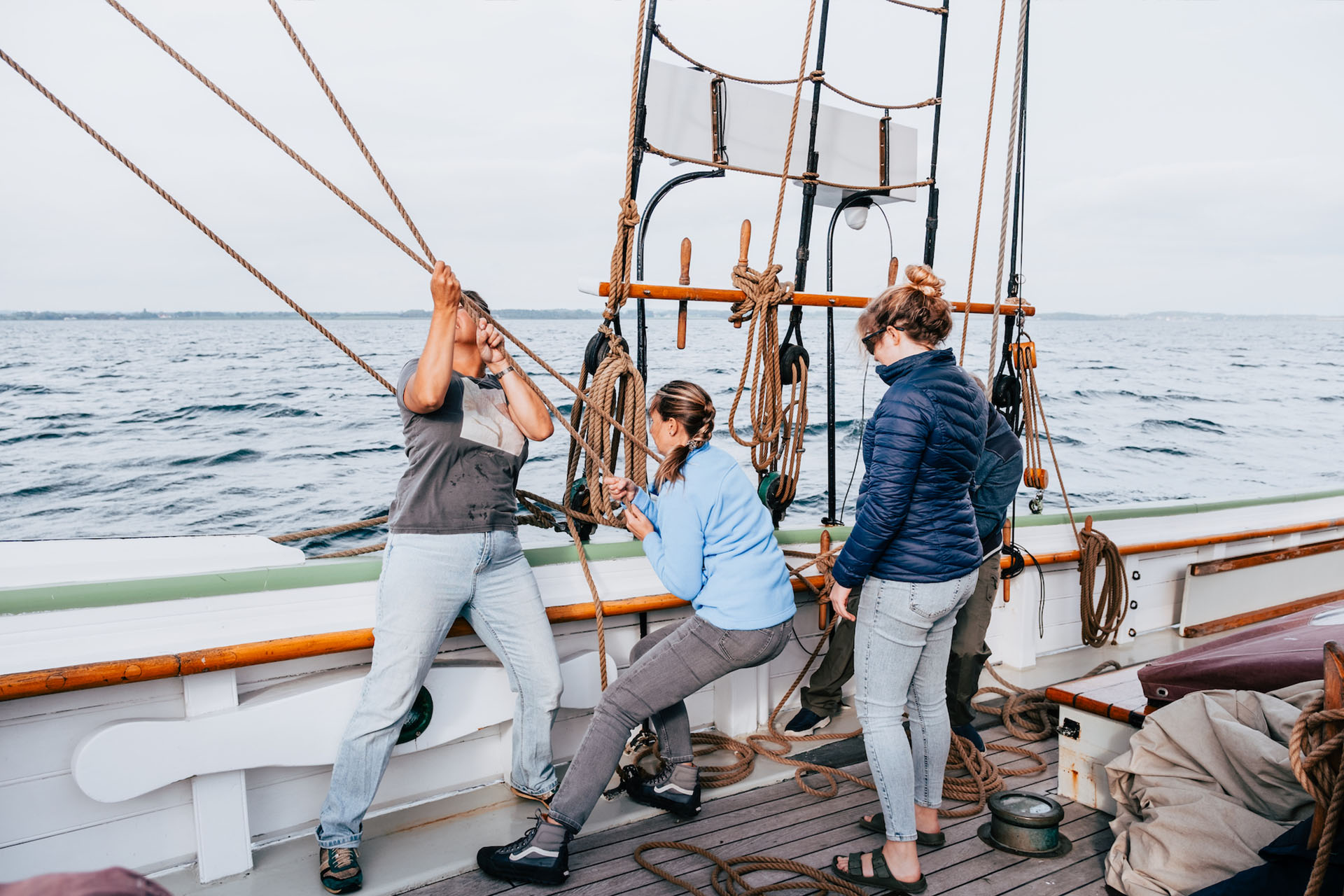
If this Denmark travel guide has inspired you to start your own adventure in South Funen, why not take a look at our sailing holidays on board Aron of Svendborg? Aron’s voyages range from a few days short break island hopping, to week long summer sailing adventures, and are perfect for solo travellers, couples, families and friends.




